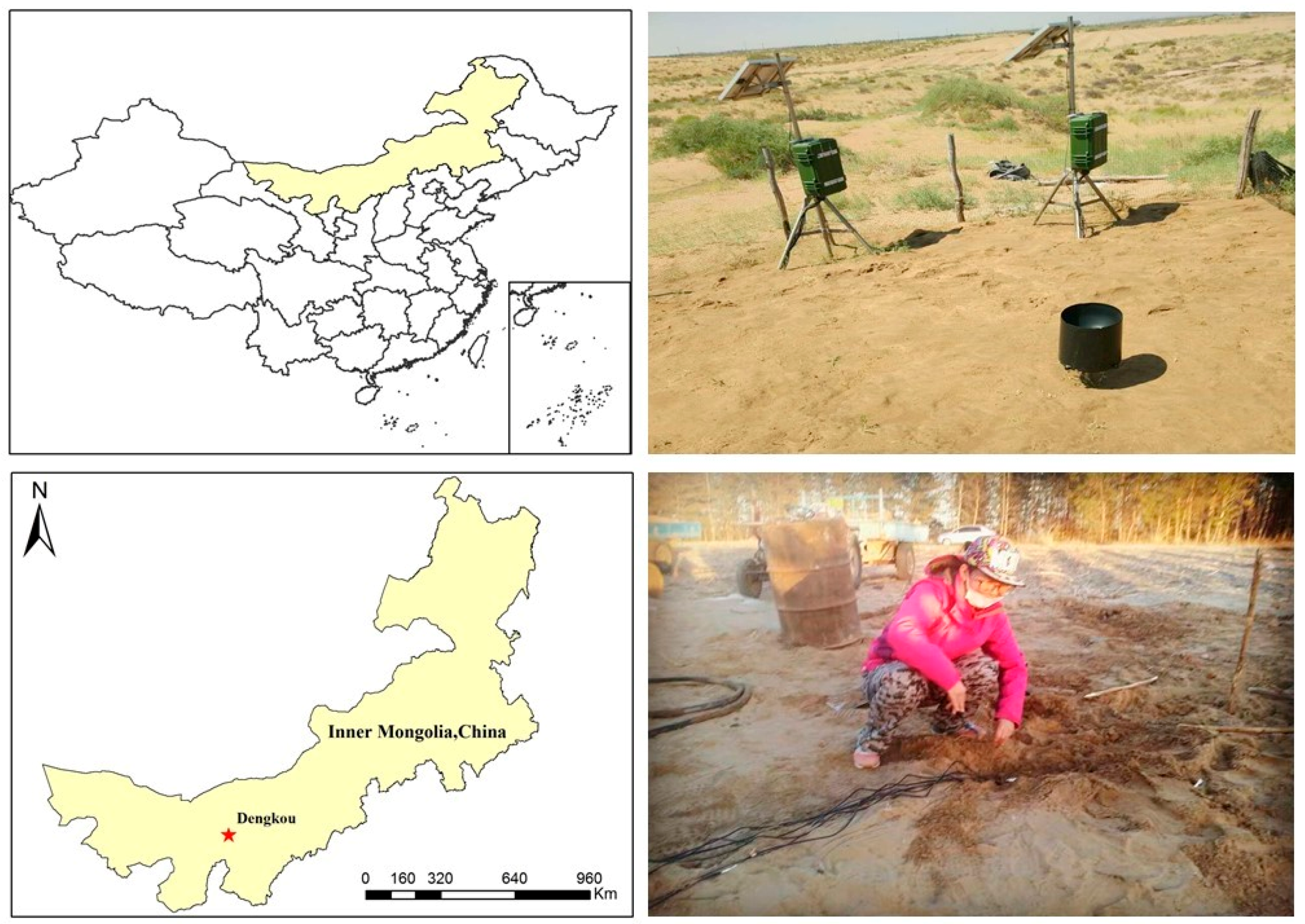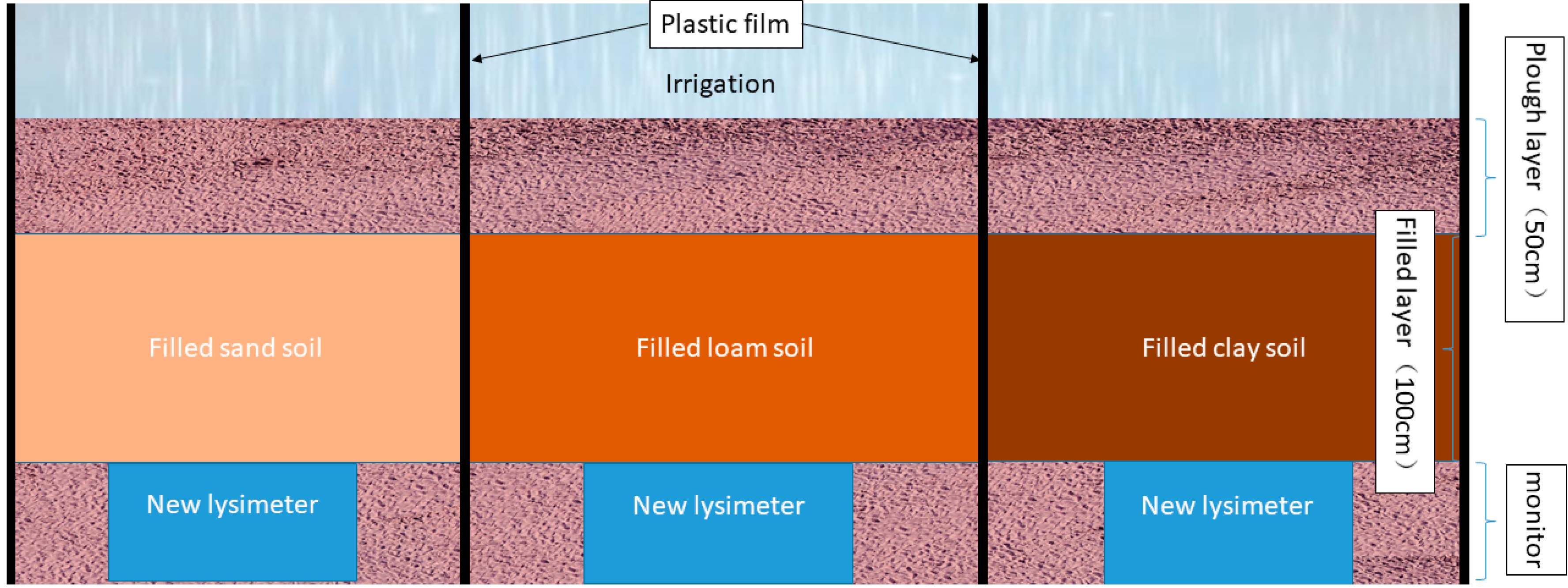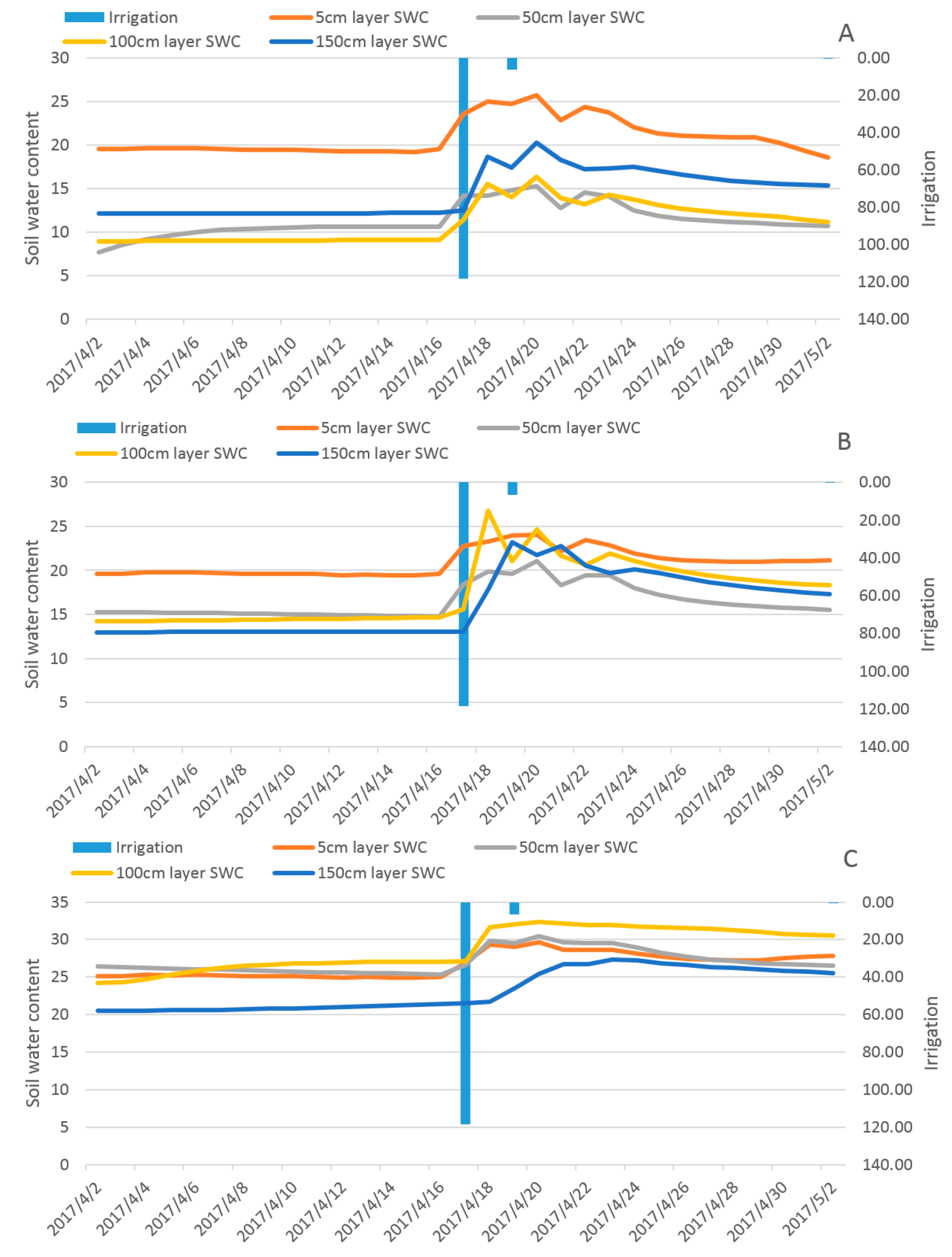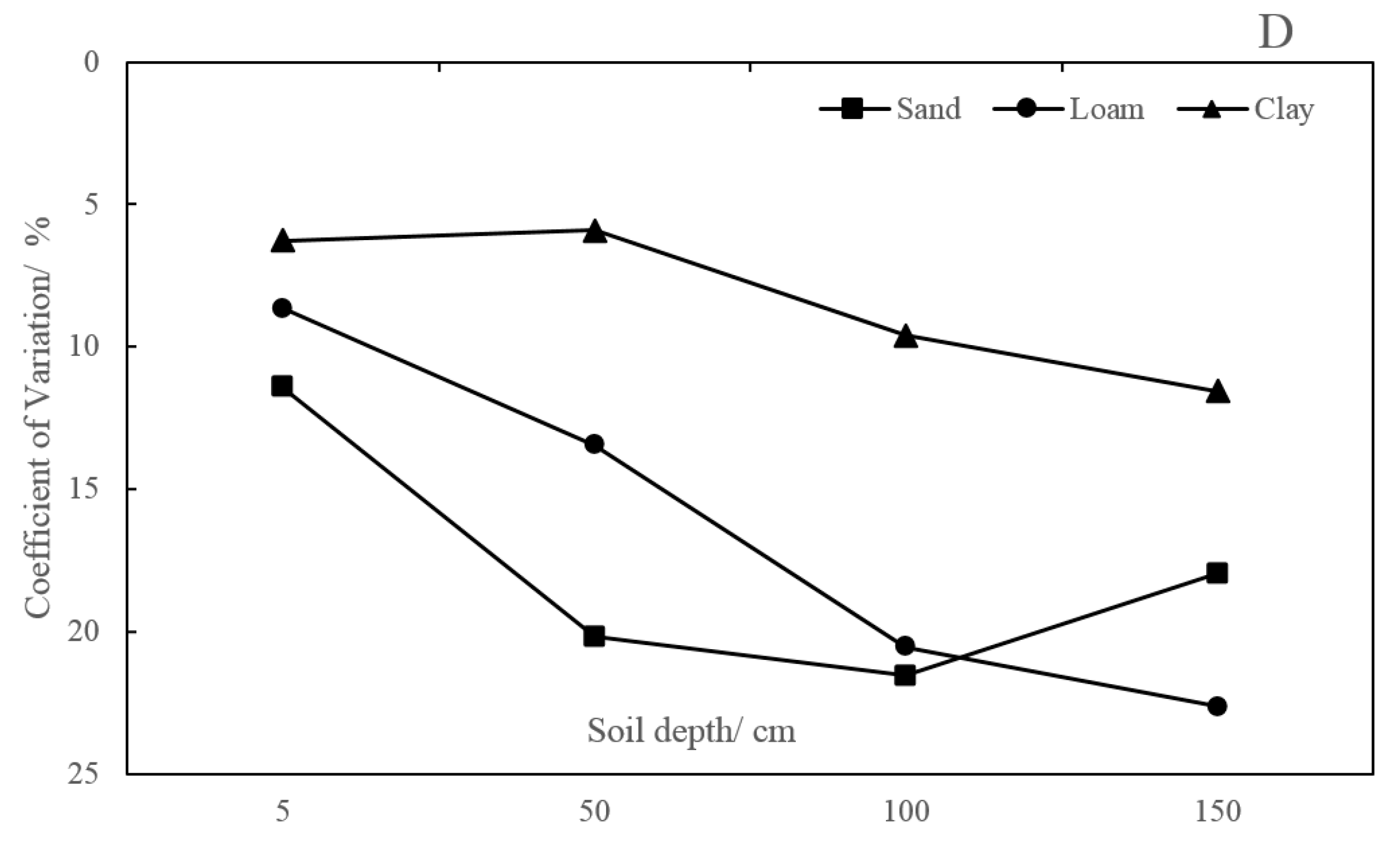New Comparative Experiments of Different Soil Types for Farmland Water Conservation in Arid Regions
Abstract
:1. Introduction
2. Study Area and Methods
2.1. Overview of the Study Area
2.2. Experimental Design
2.2.1. Sample Settings
2.2.2. Determination Indicators and Methods
3. Results and Analysis
3.1. The Dynamic Response of Different Type Soil Moisture on Irrigation
3.2. Recharging Effects of Recharge on Soil Moisture of 0–150 cm Layers
3.3. DSR Characteristics of Different Soil Types
4. Conclusions
- Accumulative irrigation in the experimental field from 2 April to 2 May is 125.14 mm. For the upper 150 cm soil layer, irrigation has significant influence on soil moisture. For the upper 50 cm plough soil layer, the irrigation influence on different soils follows the declining order of sand, loam, and clay soils under the same irrigation strength and pattern. For the filled soil layer at depth of 50–150 cm, the irrigation influence on different soils follows the declining order of loam, sand, and clay soils under the same irrigation strength and pattern.
- Irritation has recharging effect on soil moisture for all three types of soil at the upper 150 cm soil layer, and the recharge amounts follow the order of clay (54.3 mm, which is 43.39% of the total irrigation amount), loam (39.83 mm, which is 31.83% of the total irrigation amount), and sand (33.47 mm, which is 26.75% of the total irrigation amount).
- Post-irrigation DSR appears in all three types of soil below 150 cm. The time when DSR occurs is 13 h after irrigation for sand, 72 h after irrigation for loam, and 257 h after irrigation for clay. The 15-day total DSR is 110.87 mm for sand, 12.2 mm for loam, and 0.2 mm for clay.
- If one replaces the original cultivated soil layer right below the upper 50 cm plough soil whose particle sizes are mostly in the range of 1–2 µm with a 100 cm thick filled clay soil whose particles are primarily in the range of 0.71–1 μm, one can effectively reduce DSR below the 150 cm soil profile, thus achieving the goal of saving water resources for farmland in arid regions.
Acknowledgments
Author Contributions
Conflicts of Interest
References
- Noy-Meir, I. Desert ecosystems: Environment and producers. Annu. Rev. Ecol. Syst. 1973, 4, 25–51. [Google Scholar] [CrossRef]
- Flanagan, L.B.; Johnson, B.G. Interacting effects of temperature, soil moisture and plant biomass production on ecosystem respiration in a Northern Temperate Grassland. Agric. For. Meteorol. 2005, 130, 237–253. [Google Scholar] [CrossRef]
- Wallace, J. Increasing agricultural water use efficiency to meet future food production. Agric. Ecosyst. Environ. 2000, 82, 105–119. [Google Scholar] [CrossRef]
- Laurance, W.F.; Sayer, J.; Cassman, K.G. Agricultural expansion and its impacts on tropical nature. Trends Ecol. Evol. 2014, 29, 107–116. [Google Scholar] [CrossRef] [PubMed]
- Reij, C.; Waters-Bayer, A. Farmer Innovation in Africa: A Source of Inspiration for Agricultural Development; Routledge: London, UK, 2014. [Google Scholar]
- Rockström, J.; Falkenmark, M. Increase water harvesting in Africa. Nature 2015, 519, 283. [Google Scholar] [CrossRef] [PubMed]
- Dai, J.; Dong, H. Intensive cotton farming technologies in China: Achievements, challenges and countermeasures. Field Crops Res. 2014, 155, 99–110. [Google Scholar] [CrossRef]
- Canakci, M.; Topakci, M.; Akinci, I.; Ozmerzi, A. Energy use pattern of some field crops and vegetable production: Case study for Antalya Region, Turkey. Energy Convers. Manag. 2005, 46, 655–666. [Google Scholar] [CrossRef]
- Köberl, M.; Müller, H.; Ramadan, E.M.; Berg, G. Desert farming benefits from microbial potential in arid soils and promotes diversity and plant health. PLoS ONE 2011, 6, e24452. [Google Scholar] [CrossRef] [PubMed]
- Yin, X.; Song, B.; Dong, W.; Xin, W.; Wang, Y. A review on the eco-geography of soil fauna in China. J. Geogr. Sci. 2010, 20, 333–346. [Google Scholar] [CrossRef]
- Yoder, R.E. A direct method of aggregate analysis of soils and a study of the physical nature of erosion losses. Agron. J. 1936, 28, 337–351. [Google Scholar] [CrossRef]
- Wikelski, M.; Cooke, S.J. Conservation physiology. Trends Ecol. Evol. 2006, 21, 38–46. [Google Scholar] [CrossRef] [PubMed]
- Dolan, B.F. Water developments and desert bighorn sheep: Implications for conservation. Wildl. Soc. Bull. 2006, 34, 642–646. [Google Scholar] [CrossRef]
- Wang, X.; Chen, F.; Hasi, E.; Li, J. Desertification in China: An assessment. Earth-Sci. Rev. 2008, 88, 188–206. [Google Scholar] [CrossRef]
- Hao, X.; Chen, Y.; Xu, C.; Li, W. Impacts of climate change and human activities on the surface runoff in the Tarim River Basin over the last fifty years. Water Resour. Manag. 2008, 22, 1159–1171. [Google Scholar] [CrossRef]
- Tao, W. Some issues on oasification study in China. J. Desert Res. 2010, 5, 995–998. [Google Scholar]
- Zha, Y.; Gao, J. Characteristics of desertification and its rehabilitation in China. J. Arid Environ. 1997, 37, 419–432. [Google Scholar] [CrossRef]
- Liu, J.; Zhang, Z.; Xu, X.; Kuang, W.; Zhou, W.; Zhang, S.; Li, R.; Yan, C.; Yu, D.; Wu, S. Spatial patterns and driving forces of land use change in China during the early 21st century. J. Geogr. Sci. 2010, 20, 483–494. [Google Scholar] [CrossRef]
- Ezcurra, E. Global Deserts Outlook; UNEP/Earthprint: Hertfordshire, UK, 2006. [Google Scholar]
- Abtew, W.; Melesse, A. Landscape Dynamics and Evapotranspiration. In Proceedings of the World Environmental and Water Resources Congress, West Palm Beach, FL, USA, 22–26 May 2016. [Google Scholar]
- Oestigaard, T. Water Scarcity and Food Security along the Nile: Politics, Population Increase and Climate Change; Nordiska Afrikainstitutet: Uppsala, Sweden, 2012. [Google Scholar]
- Schwinning, S.; Sala, O.E. Hierarchy of responses to resource pulses in arid and semi-arid ecosystems. Oecologia 2004, 141, 211–220. [Google Scholar] [CrossRef] [PubMed]
- West, N.E. Structure and function of microphytic soil crusts in wildland ecosystems of arid to semi-arid regions. Adv. Ecol. Res. 1990, 20, 179–223. [Google Scholar]
- Jolly, I.D.; McEwan, K.L.; Holland, K.L. A review of groundwater-surface water interactions in arid/semi-arid wetlands and the consequences of salinity for wetland ecology. Ecohydrology 2008, 1, 43–58. [Google Scholar] [CrossRef]
- Laity, J.J. Deserts and Desert Environments; John Wiley & Sons: Hoboken, NJ, USA, 2009. [Google Scholar]
- Zhao, H.; Li, G.; Sheng, Y.; Jin, M.; Chen, F. Early–middle Holocene lake-desert evolution in northern Ulan Buh Desert, China. Palaeogeogr. Palaeoclimatol. Palaeoecol. 2012, 331, 31–38. [Google Scholar] [CrossRef]
- Chen, J.; He, D.; Cui, S. The response of river water quality and quantity to the development of irrigated agriculture in the last 4 decades in the Yellow River Basin, China. Water Resour. Res. 2003, 39. [Google Scholar] [CrossRef]
- McKendry, P. Energy production from biomass (part 1): Overview of Biomass. Bioresour. Technol. 2002, 83, 37–46. [Google Scholar] [CrossRef]
- Grubb, P.J. The maintenance of species-richness in plant communities: The importance of the regeneration niche. Biol. Rev. 1977, 52, 107–145. [Google Scholar] [CrossRef]
- Kravchenko, A.N.; Bullock, D.G. Correlation of corn and soybean grain yield with topography and soil properties. Agron. J. 2000, 92, 75–83. [Google Scholar] [CrossRef]
- Hassan, N.A.; Drew, J.V.; Knudsen, D.; Olson, R.A. Influence of soil salinity on production of dry matter and uptake and distribution of nutrients in barley and corn: I. Barley (Hordeum vulgare L.). Agron. J. 1970, 62, 43–45. [Google Scholar] [CrossRef]
- Fereres, E.; Soriano, M.A. Deficit irrigation for reducing agricultural water use. J. Exp. Bot. 2006, 58, 147–159. [Google Scholar] [CrossRef] [PubMed]
- Ayars, J.; Phene, C.; Hutmacher, R.; Davis, K.; Schoneman, R.; Vail, S.; Mead, R. Subsurface drip irrigation of row crops: A review of 15 years of research at the Water Management Research Laboratory. Agric. Water Manag. 1999, 421, 1–27. [Google Scholar] [CrossRef]
- Herkelrath, W.; Hamburg, S.; Murphy, F. Automatic, real time monitoring of soil moisture in a remote field area with time domain reflectometry. Water Resour. Res. 1991, 27, 857–864. [Google Scholar] [CrossRef]
- Scott, R.L.; Shuttleworth, W.J.; Keefer, T.O.; Warrick, A.W. Modeling multiyear observations of soil moisture recharge in the semiarid American Southwest. Water Resour. Res. 2000, 36, 2233–2247. [Google Scholar] [CrossRef]
- Klute, A. Water Retention: Laboratory Methods; Soil Science Society of America, American Society of Agronomy: Madison, WI, USA, 1986. [Google Scholar]
- Eching, S.; Hopmans, J.; Wendroth, O. Unsaturated hydraulic conductivity from transient multistep outflow and soil water pressure data. Soil Sci. Soc. Am. J. 1994, 58, 687–695. [Google Scholar] [CrossRef]
- Campbell, G.S. A simple method for determining unsaturated conductivity from moisture retention data. Soil Sci. 1974, 117, 311–314. [Google Scholar] [CrossRef]
- Van Genuchten, M.T. A closed-form equation for predicting the hydraulic conductivity of unsaturated soils. Soil Sci. Soc. Am. J. 1980, 44, 892–898. [Google Scholar] [CrossRef]
- Zhang, X.Y.; Arimoto, R.; An, Z.S. Dust emission from Chinese desert sources linked to variations in atmospheric circulation. J. Geophys. Res. 1997, 102, 28041–28047. [Google Scholar] [CrossRef]
- Chun, X.; Hen, F.; Fan, Y.; Xia, D.; Zhao, H. Formation of Ulan Buh Desert and its environmental evolution. J. Desert Res. 2007, 6, 005. [Google Scholar]
- Cheng, Y.; Zhan, H.; Yang, W.; Dang, H.; Li, W. Is annual recharge coefficient a valid concept in arid and semi-arid regions? Hydrol. Earth Syst. Sci. 2017, 21, 5031. [Google Scholar] [CrossRef]
- Modaihsh, A.S.; Horton, R.; Kirkham, D. Soil water evaporation suppression by sand mulches. Soil Sci. 1985, 139, 357–361. [Google Scholar] [CrossRef]
- Liu, X.P.; Zhang, T.H.; Zhao, H.L. Influence of dry sand bed thickness on soil moisture evaporation in mobile dune. Arid Land Geogr. 2006, 29, 523–526. [Google Scholar]






| Soil Type | Soil Mechanical Composition/µm | |||||||||
|---|---|---|---|---|---|---|---|---|---|---|
| 0.71–1.00 | 1.00–2.00 | 2.00–5.00 | 5.00–10.00 | 10.00–20.00 | 20.00–50.00 | 50.00–100.00 | 100.00–200.00 | 200.00–500.00 | 500.00–1000.00 | |
| Plough layer | 22.84% | 53.47% | 23.07% | 0.62% | 0 | 0 | 0 | 0 | 0 | 0 |
| Sand | 1.05% | 2.49% | 1.03% | 0.02% | 0.04% | 0.68% | 2.59% | 70.41% | 21.33% | 0.36% |
| Loam | 50.41% | 49.56% | 0.03% | 0 | 0 | 0 | 0 | 0 | 0 | 0 |
| Clay | 69.18% | 30.82% | 0 | 0 | 0 | 0 | 0 | 0 | 0 | 0 |
| Soil Depth | Soil Type | Date (Month-Day) | Water Content Maximum/% | Date (Month-Day) | Water Content Minimum/% |
|---|---|---|---|---|---|
| 5 cm | Sand | 4-17 | 31.35 | 5-2 | 18.11 |
| Loam | 4-17 | 31.31 | 4-12 | 19.11 | |
| Clay | 4-17 | 30.91 | 4-12 | 24.56 | |
| 50 cm | Sand | 4-17 | 25.29 | 4-2 | 7.158 |
| Loam | 4-17 | 28.96 | 4-16 | 14.72 | |
| Clay | 4-20 | 30.83 | 4-16 | 25.37 | |
| 100 cm | Sand | 4-17 | 20.56 | 4-2 | 8.87 |
| Loam | 4-18 | 31.29 | 4-2 | 14.2 | |
| Clay | 4-20 | 32.53 | 4-2 | 24.24 | |
| 150 cm | Sand | 4-20 | 22.12 | 4-2 | 12.11 |
| Loam | 4-18 | 25.21 | 4-2 | 12.93 | |
| Clay | 4-23 | 27.41 | 4-2 | 20.5 |
| Soil Type | 2 April 2017 Storage/mm | 2 May 2017 Storage/mm | Difference of 2 April and 2 May 2017/mm |
|---|---|---|---|
| Sand | 178.10 | 211.57 | 33.47 |
| Loam | 231.09 | 271.91 | 39.83 |
| Clay | 360.45 | 414.75 | 54.30 |
© 2018 by the authors. Licensee MDPI, Basel, Switzerland. This article is an open access article distributed under the terms and conditions of the Creative Commons Attribution (CC BY) license (http://creativecommons.org/licenses/by/4.0/).
Share and Cite
Cheng, Y.; Li, Y.; Zhan, H.; Liang, H.; Yang, W.; Zhao, Y.; Li, T. New Comparative Experiments of Different Soil Types for Farmland Water Conservation in Arid Regions. Water 2018, 10, 298. https://doi.org/10.3390/w10030298
Cheng Y, Li Y, Zhan H, Liang H, Yang W, Zhao Y, Li T. New Comparative Experiments of Different Soil Types for Farmland Water Conservation in Arid Regions. Water. 2018; 10(3):298. https://doi.org/10.3390/w10030298
Chicago/Turabian StyleCheng, Yiben, Yanli Li, Hongbin Zhan, Hairong Liang, Wenbin Yang, Yinming Zhao, and Taojia Li. 2018. "New Comparative Experiments of Different Soil Types for Farmland Water Conservation in Arid Regions" Water 10, no. 3: 298. https://doi.org/10.3390/w10030298
APA StyleCheng, Y., Li, Y., Zhan, H., Liang, H., Yang, W., Zhao, Y., & Li, T. (2018). New Comparative Experiments of Different Soil Types for Farmland Water Conservation in Arid Regions. Water, 10(3), 298. https://doi.org/10.3390/w10030298






